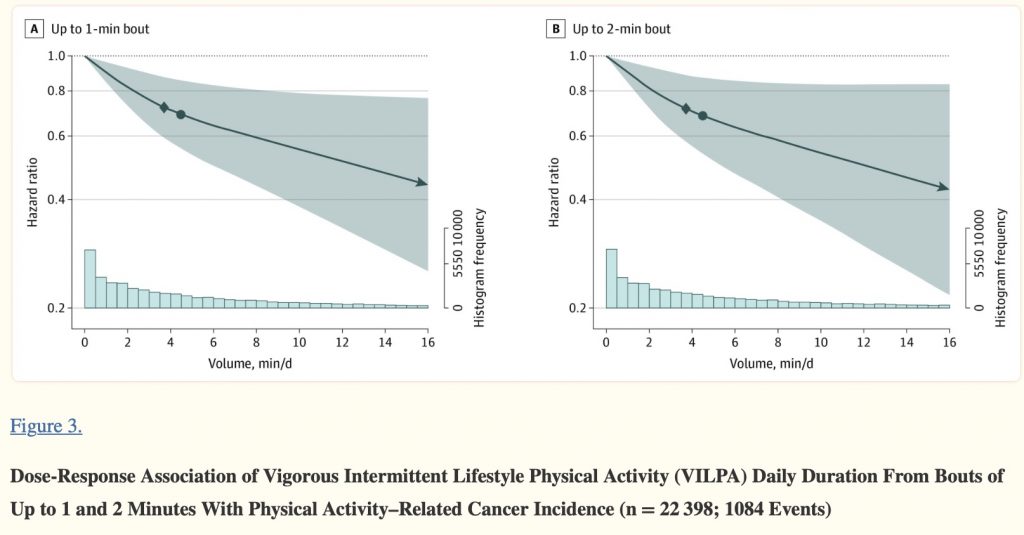The article from Stamatakis et al. 2023 aims to evaluate the relationship between short bursts of vigorous intermittent lifestyle physical activity (VILPA) and the risk of developing cancer among adults who do not engage in regular exercise, to identify the minimal effective dose for cancer risk reduction.
The study used data from the UK Biobank wrist accelerometry substudy, focusing on 22,398 adults who reported no leisure-time exercise and wore accelerometers to measure their physical activity. The analysis included adjustments for various factors like age, sex, body mass index, and lifestyle habits.
The study found that even small amounts of daily VILPA, as little as 3.4 to 3.7 minutes per day, were associated with a significant reduction in cancer risk. Specifically, a median daily VILPA of 4.5 minutes was linked to a 31-32% reduction in physical activity-related cancer incidence.

The findings suggest that short bursts of vigorous activity can significantly lower cancer risk, making VILPA a promising intervention for cancer prevention in individuals who are unable or unmotivated to engage in structured exercise.
One limitation is that the leisure-time exercise data used to select participants were collected an average of 5.5 years before the accelerometry data, which may affect the accuracy of the sample inclusion criteria.
The study implies that incorporating short bursts of vigorous activity into daily routines could be a feasible and effective strategy for cancer prevention, especially for those who find traditional exercise unappealing.
The observational nature of the study means it cannot establish causation, and there may be unmeasured confounding factors that could influence the results.
A major strength is the use of device-measured physical activity, which provides more accurate and objective data compared to self-reported measures.
The main argument that short, vigorous activities can reduce cancer risk is compelling and supported by robust data, making it a valuable addition to your health strategies for cancer prevention .
Check my book “Das Osteopathie Selbsthilfe-Buch“ as this study’s findings support the practical tips in my book for incorporating these small but impactful lifestyle changes to promote self-healing and wellness. Short vigorous intermittent activity shows positive outcomes regardless of traditional exercise habits.
Stamatakis E, Ahmadi MN, Friedenreich CM, Blodgett JM, Koster A, Holtermann A, Atkin A, Rangul V, Sherar LB, Teixeira-Pinto A, Ekelund U, Lee IM, Hamer M. Vigorous Intermittent Lifestyle Physical Activity and Cancer Incidence Among Nonexercising Adults: The UK Biobank Accelerometry Study. JAMA Oncol. 2023 Sep 1;9(9):1255-1259. doi: 10.1001/jamaoncol.2023.1830. PMID: 37498576; PMCID: PMC10375384.
Check body exercises on my YouTube Channel

